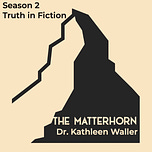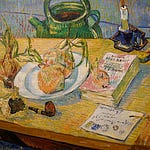Today’s podcast is part of a series to accompany my current serialized novel, An Interpreter in Vienna, as we investigate the truth in fiction. You can also listen to the podcast via Apple or Spotify or in the Substack app. Please consider adding a quick star rating on the other players to help my reach.
I appreciate your support as a Matterhorn subscriber and look forward to our discussions. As always, feel free to share any of your work related to the conversation. Thank you!

A full AI-created transcript can be accessed on the desktop version.
Keywords:
Iconic painters of a culture or place
Vienna: Gustav Klimt
Destruction/seizing of visual arts
Literature:
J. D. Salinger
Herman Melville
Natsume Sōseki
Haruki Murakami
Considerations for your work
Considerations for your work:
How might you include allusion to a painting or painter to consider an idea through artistic movement, biographical elements, or the nature of encountering the painting itself?
How might you include visual arts in a fictional text to advance the discourse around art and artistry?
In what ways can the inclusion of visual arts in your fiction help the reader/viewer to understand places and cultures on different levels or from different perspectives?
Feel free to share your related work or recommendations in the comments.
Texts:
Sothebys on Klimt style (and Japonisme)
Woman in Gold, film
Gustav Klimt, a record-breaking painter who symbolizes the looting of Jewish art by the Nazis
Against a Canvas of Despair, Gaza’s Artists Trace Their Struggle
“De Daumier Smith’s Blue Period,” J.D. Salinger (Nine Stories)
Russell, John. “Salinger, from Daumier to Smith.” Wisconsin Studies in Contemporary Literature 4, no. 1 (1963): 70–87. https://doi.org/10.2307/1207186.
Whitburn, Merrill D. “‘MOBY-DICK’ AND THE SUBLIME.” The Comparatist 3 (1979): 32–39. http://www.jstor.org/stable/44366653.
Rubin, Jay, and Natsume Soseki. “Sōseki on Individualism. `Watakushi No Kojinshugi’.” Monumenta Nipponica 34, no. 1 (1979): 21–48. https://doi.org/10.2307/2384280.
Moby Dick, Herman Melville
Bassoe, Pedro Thiago Ramos. “Judging a Book by Its Cover: Natsume Sōseki, Book Design, and the Value of Art.” Review of Japanese Culture and Society 29 (2017): 159–74. https://www.jstor.org/stable/48629193.
Kin’ya Tsuruta. “Sôseki’s Kusamakura: A Journey to ‘The Other Side.’” The Journal of the Association of Teachers of Japanese 22, no. 2 (1988): 169–88. https://doi.org/10.2307/488940.
ETŌ, JUN. “Natsume Sōseki: A Japanese Meiji Intellectual.” The American Scholar 34, no. 4 (1965): 603–19. http://www.jstor.org/stable/41209314.
BATTIGELLI, ANNA, ed. Art and Artifact in Austen. University of Delaware Press, 2020. https://doi.org/10.2307/j.ctvwvr2z6.
“Kusamakura, Natsume Sōseki (translated as Unhuman Tour and The Three-Cornered World)
Killing Commendatore, Haruki Murakami
Kafka on the Shore, Murakami
The Picture of Dorian Gray, Oscar Wilde














Share this post